Ah, chickens, one of the first animals you are likely to buy on a new Stardew Valley run through. Chickens are some of the earliest animals available in the game and at the right size offer eggs which can be sold, cooked, or made into mayo. At high levels this leads to a lot of profit in the game for relatively little upkeep as long as you do things right in the very beginning.
Chickens can be a huge source of income in Stardew Valley. However to be profitable they need to be properly fed, cared for, and eggs produced into artisan goods to get the most out of your chicken coop investment. Keeping chickens fed and happy is crucial to making your chicken farming a smashing success!
So how do you get your first chickens? How do you get the special ones? How do you keep them happy and avoid the problem of grumpy chickens on egg-laying strike? Read on for all these answers and everything else you need to know about chickens in the game of Stardew Valley!
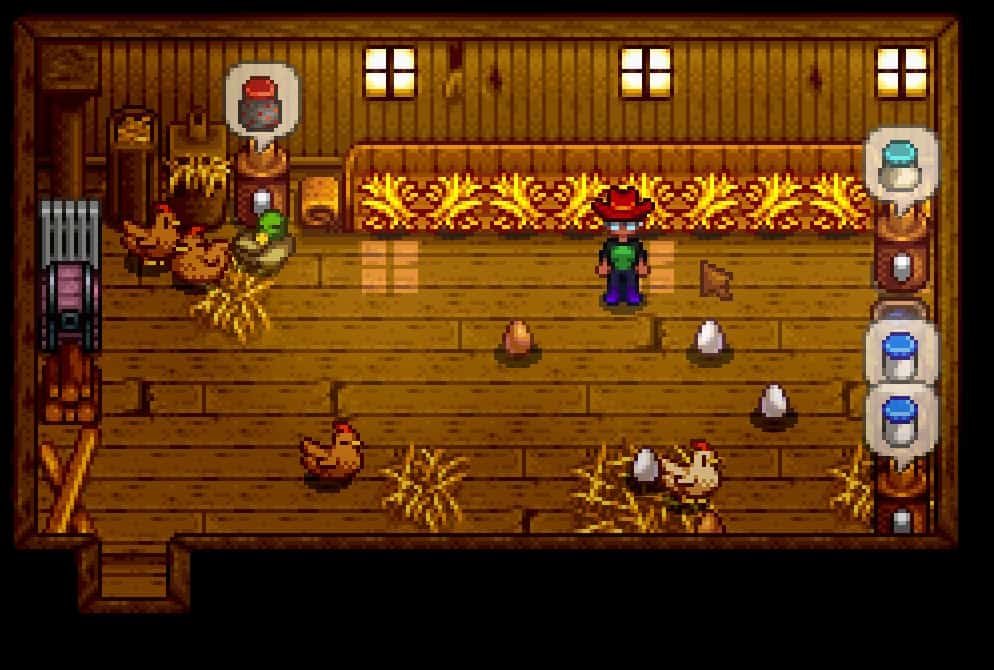
How Do You Get Chickens in Stardew Valley
Getting chickens in Stardew Valley isn’t difficult, but it will require a bit of work…including several days’ worth of energy in the beginning to get all the resources Robin needs and the money that Robin and Marnie will both need. There are a couple of side options for how to do this, but the following is the simplest, most direct, and best long-term setup so you’re good to go from day one of your coop.
Step 1: Pay Robin to Build a Silo
Truth be told, I would do this even before getting a chicken coop. While technically you don’t need to…it saves you money and prevents a lot of headaches down the line. Most of my farms have a minimum of 4-5 silos to hold excess hay, especially since I like to use the Wilderness Farm which has plenty of grass, though this still is a good strategy with any farm.
The good news is a silo is cheap. Make sure to clear an out a 3×3 out of the way space on your farm where it can be built and then you only need 100 gold, 100 stone, 10 clay, and 5 copper bars to pay to Robin to build.
This will allow you to scythe grass to store up to 250 pieces of hay before buying your first birds. Very, very useful.
While you could argue this step is optional…it’s really a bad move in every measurable way not to have a silo before a coop.
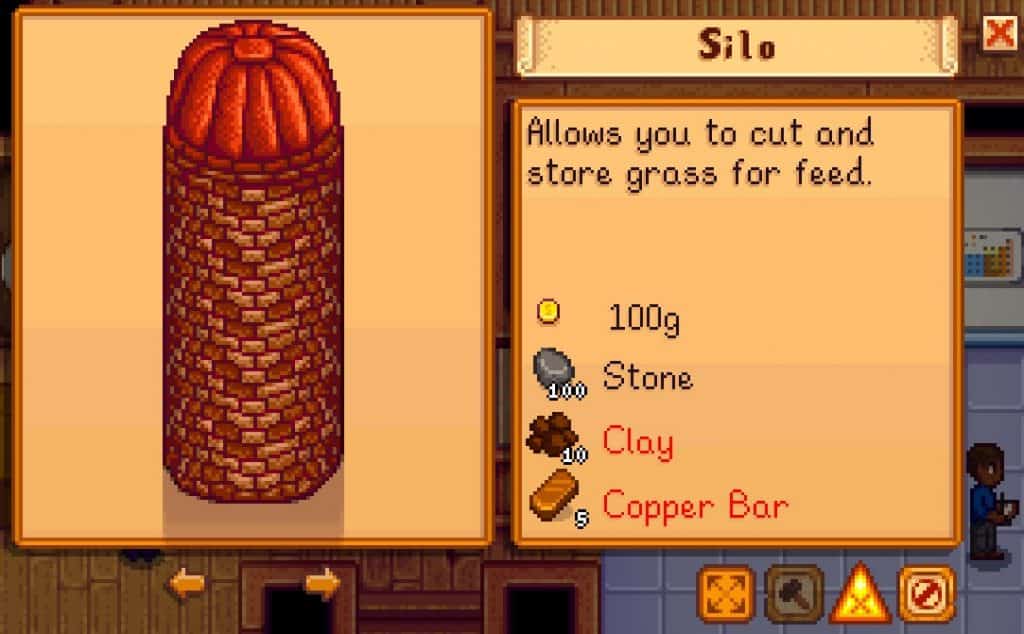
Step 2: Pay Robin to Build a Coop
You need the building before you can get the animals. A basic chicken coop is one of the first buildings you’ll be quested with building. Once again it’s time to visit Robin the local carpenter.
She will require:
- 300 pieces of wood
- 100 pieces of stone
- 4,000 gold to build a coop.
This will allow you to store up to four chickens. You’ll need to expand for more chickens or to expand to other birds and/or coop animals.
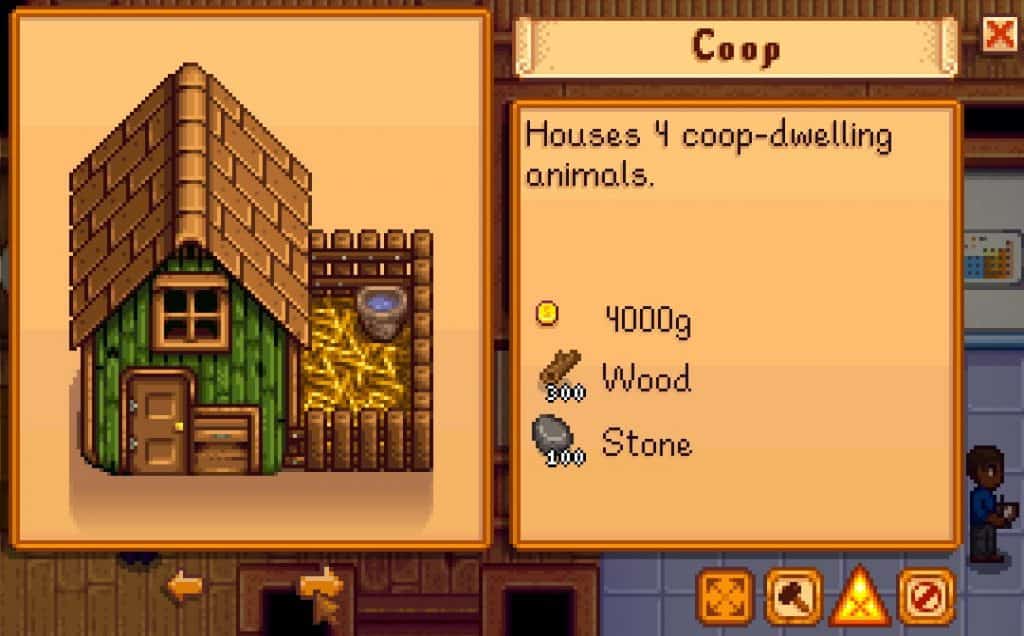
Step 3: Pay Marnie for Your First Chicken (or Chickens)
Chickens cost 800 gold a piece and don’t require any other resources. If you have the money, you can buy a chicken. I tend to buy 3-4 at once if I have the money not only to speed up the process of getting eggs and eventually valuable mayo, but to complete the bundle for the Greenhouse in the Community Center you will need a brown egg and a white egg, but it’s random which chicken you get.
So buy four and you’ll almost certainly have at least one brown and one white.
This is also a good reason to have silos: so you have plenty of hay that you don’t have to pay for in the beginning, otherwise you can spend many hundreds of gold for hay when you could have saved that for a more important purchases.
Total Cost for First Chicken: 300 pieces of wood, 200 pieces of stone, 10 clay, 5 copper bars (which can be bought from Clint or built with 25 stone and 20 copper ore), and 4,100 gold to Robin as well as 800 gold to Marnie for the first chicken.
I highly recommending buying 3-4 chickens and making sure you have dozens if not hundreds of pieces of hay stored before buying your first chickens. This saves you money and the danger of angering your chickens from not feeding them because you can’t buy hay during one of the many times Marnie’s shop is closed.
That’s it. Then the key is making sure to keep the chickens happy so they keep producing eggs (they stop if they get angry – and young chicks need to be happy to grow).
How to Feed Chickens in Stardew Valley
Feeding chickens in Stardew Valley is pretty simple, though it’s easy to see how some first time players might be confused as there isn’t a lot of guidance in the first run through.
When a coop of any size is built it comes with the hay hopper, and a feed box. Take a look at the picture below to see them clearly marked. This is a Big Coop so it will have extras like an incubator, auto grabber (because I’m lazy), and three ducks with familiar sounding names to children of the early 1990s, but the setup is basically the same for your basic coop, just smaller.
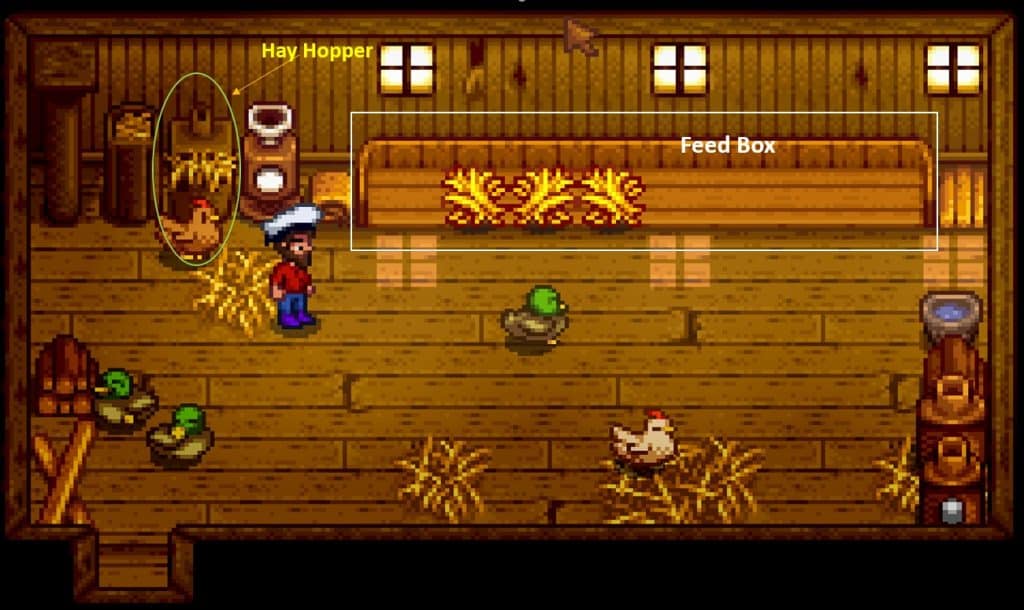
The feed box is what you need to fill with hay. You can have hay in three places:
- You can buy hay from Marnie and keep it in one of your precious inventory slots
- You can buy hay from Marnie and keep it in a storage box you will need to grab it from every single day
- Or you can be smart about it, build the silo, and the silo will AUTOMATICALLY send it to the Hay Hopper in the Coop.
It’s important to note that this won’t auto feed the animals. You still need to grab the feed from the hopper and put it in the feed box, but all the hay in your silos can automatically be grabbed from the hopper.
Step 1: Approach the Hopper
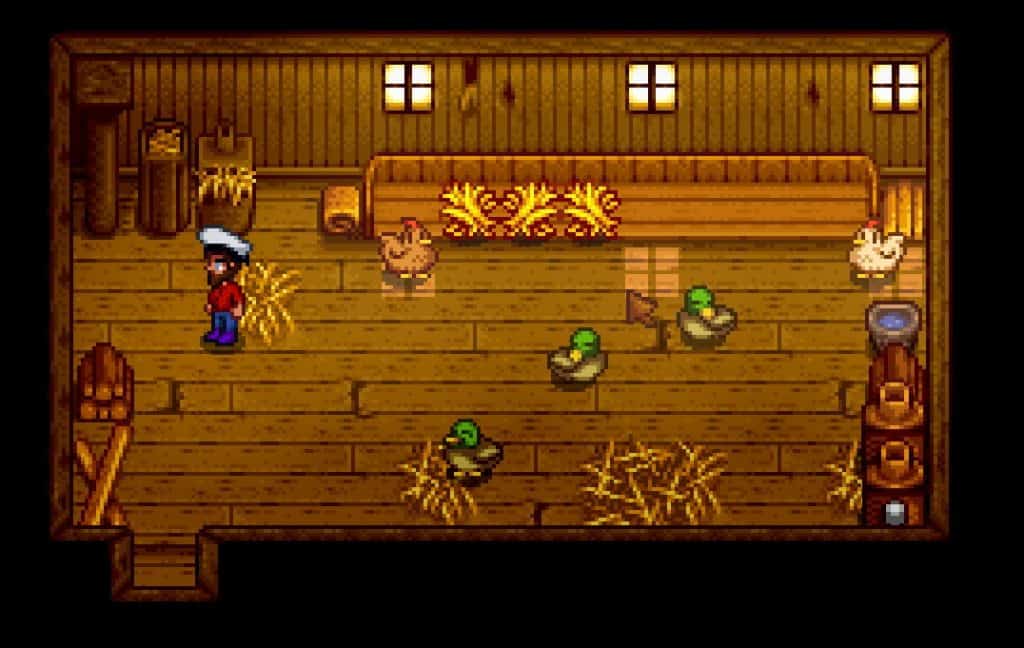
Step 2: Pull Hay from the Hopper

Step 3: Drop the Hay in the Feed Box for Happy Chickens.
Nice and easy once you see what the Hopper is, right?
If you need to feed chickens in Stardew Valley without a silo you MUST buy hay from Marnie. And don’t even think about selling excess – it’s worth zero. You also won’t get hay from harvesting grass until you have a silo to put it in. If Marnie is closed and you’re out of hay…you’re about to have some angry chickens you need to make it up to.
During non-winter seasons, and non-rainy days, you also can let them out of the coop to feed in nearby grass. This can work for feeding them outside the coop, with or without a silo. However, if the grass is a little too far away it won’t work and they will still be angry.
Why You Still Need Hay (aka Grass Is Not Enough)
There are good reasons for opening the coop door and letting the chickens eat in outside grass. When they eat from the grass it not only saves you money on hay but the being outside and eating from the grass actually gives them a bonus boost to mood. That’s definitely not something to sneeze at as you race to fill out their hearts and go towards higher rated eggs (and mayo, by extension).
But chickens can’t go out during the winter.
They can’t go out while it’s raining, either.
And it’s fairly easy to harvest too much close to the coop, putting remaining grass in the farm too far away to count for feeding, even if the chickens make it there on screen.
PRO TIP: Just because the chickens go to the grass on screen doesn’t mean they will count as fed. I’ve run into this unfortunate (Bug? Glitch? Reality?) before and it feels bad spending days making up for starving them when they looked happy and fine the day before. So always check the hay in the coop. If it’s disappearing, you need to keep filling it.
When you can have them feed in nearby grass, that’s ideal. But it’s not always possible. Load up several silos with hay, check the feed box daily, and you will be in good shape.
Why Are My Chickens Grumpy?
You go to hug your chicken and get an angry cartoon head of steam in return instead of the heart you were hoping for. Uh-oh, a Stardew farmer has screwed up. But why are your Stardew Valley chickens grumpy?
There are a couple potential reasons, and how quickly you recover depends on how egregious the problems and how long they went on without getting corrected.
Reason 1: You Forgot to Feed Them
The main reason why chickens are not happy in Stardew Valley will be due to not getting fed. This could happen from just getting busy and forgetting (easier to do than you’d think), from the grass outside being too far away, or from running out of hay. It is possible to have 1-2 chickens grumpy and the others fine if some hay was out, but not enough for all of them.
Reason 2: You Withheld the Hugs
Not sure why. Maybe you just want to keep things professional. Whatever. Hugging the animals each morning by interacting with them gets them in a good mood and can cover over minor sins (but not lack of food).
Reason 3: An Animal Was Taken by Wolves Overnight and Your Surviving Animals Are Terrified
If somehow an animal was locked out at night and the event of wild animals coming on the farm is triggered you not only lose an animal, but the next day (sometimes for a few days) all the animals when you interact with them will bring up a special message about looking frightened with the tag line “Something terrible must have happened.”
Apparently chicken PTSD is very real in the wrong unfortunate circumstances.
The 3 H’s of Happy Chickens in Stardew Valley
Keeping the chickens happy isn’t that hard. Just follow the three basic H’s and you’ve pretty much got it covered. As long as you feed them every day the rest just speed up the process – but following the 3 H’s of Hugs, Hay, and Heat will help you speed up the heart process.
Hugs
One of the easiest ways to boost their mood. The boost in mood for petting them is actually much higher than the loss for ignoring them. Ignoring your chickens for a day, or even a few, won’t have a long-term net negative effect as long as you keep the chickens fed and pet them every few days.
One hug is like the equivalent of missing them for three days or something close to that. If you hug the chickens daily their mood improves drastically, especially if you do so BEFORE letting them out into the grass. There is a weird bit of programming where you don’t get the same boost if you hug them after they eat in the grass, so keep that in mind.
Chickens in Stardew Valley love hugs.
Hay
Always have hay in the feeding trough. Always have enough hay in the silos to make it through the winter. This is damage control. That way no matter what weird things happen (rain, winter, being in grass but coming back to the coop hungry anyway for some reason) they at least get to eat and you avoid the big penalty for hungry fowl.
Always have plenty of hay in the feeding trough, hay hopper, and silos.
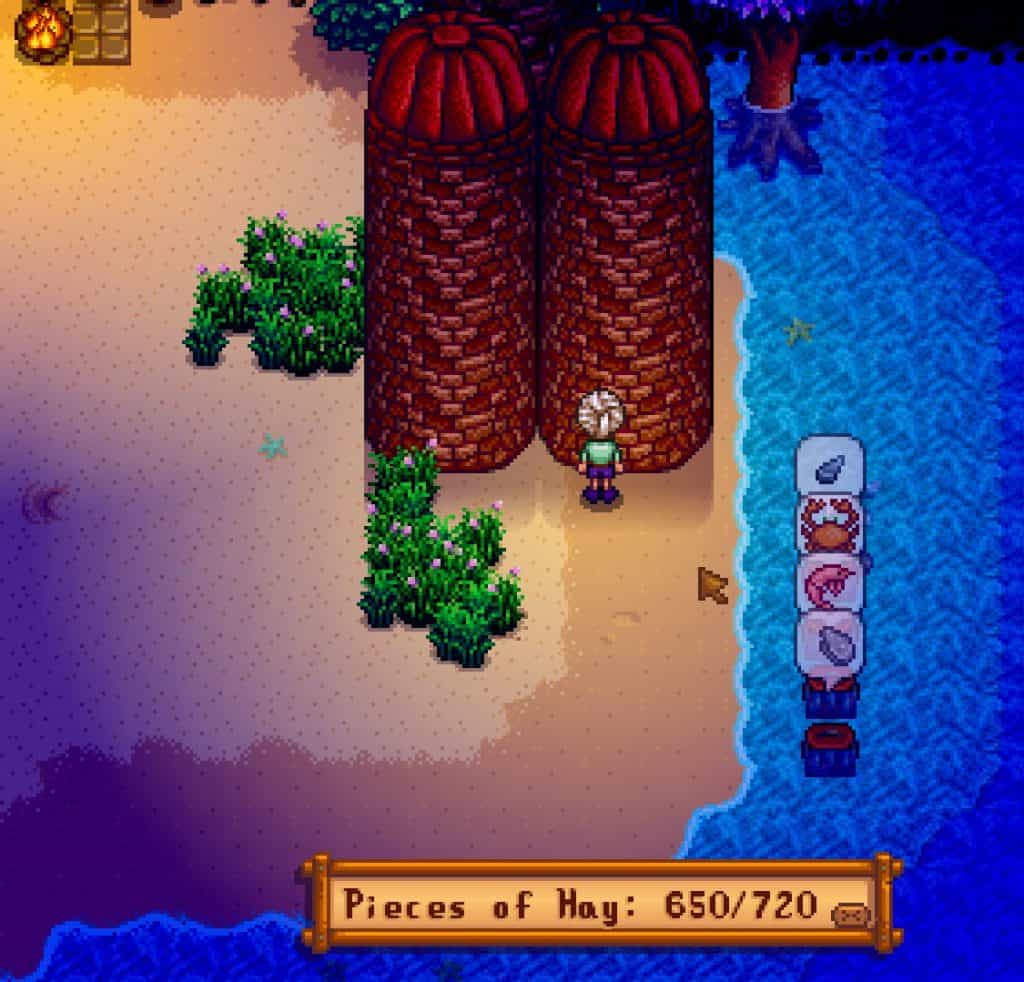
Heat
Heaters are a giant positive bonus in winter, as well as taking away the penalty for weather if you don’t have one. Because of that having a heater in the coop (or multiple coops if you own more than one) is a HUGE part of keeping your chickens happy.
This is doubly important if you get new ones at the end of fall to early winter that don’t have hearts built up yet.
That’s it.
When in doubt just take care of these three things and your chickens will be happy, healthy, and providing plenty of eggs.
The happier they get, the better the quality of eggs they produce, as well. And that leads to a higher chance of silver, gold, or even iridium star mayo, as well!
Should I Let My Chickens Out of the Coop in Stardew Valley?
Players should definitely let the chickens out of the coop. They are much happier feeding off nearby grass and get a mood boost from being outside and feeding on something other than hay. This also saves you cost from having to buy hay or time from having to harvest hay.
IMPORTANT: Do NOT close the door to the coop until all the chickens have already gone back in for the night (usually 6 PM or 7 PM). Because if you do and forget to let them all in not only will they be upset, but this is the one and only way you have a chance to lose your chicken to wild animals who take it away for dinner.
Many players have a fenced in area and grow grass in that area. You have that as an option or you can just let them free range which is what I usually do.

The good news is that if the door stays open overnight, there is no penalty. So don’t worry about it during the non-winter season.
And there’s no reason for those doors to be open during the winter, anyway, since the chickens won’t go outside in the snow.
Leaving the door open overnight can make it hard to track them all down in the morning, which means a few might not get their hug, but the same event that can cause outside animals to get grabbed does not allow those wild animals into the coop even when the door is open all night.
The pros far outweigh the cons of letting the chickens out of the coop. They will be happy, healthier chicken when you let them go free range for at least a while.
Except in winter.
Just keep the door shut in winter.
Can Your Chickens Die in Stardew Valley?
Most of the time, no, you’re in no danger of having your chickens die. There is one very specific situation where it is possible to lose an animal (including chickens) but you really have to go out of your way to screw up that badly on accident. Which admittedly, I did in my first 20 hours of game play.
Because apparently I’m special in that way.
As long as you’re careful with building any pens you should be fine, though it is technically possible for your chickens to die in Stardew Valley. If you want the full details on how chickens can die in Stardew Valley just check out that article.
Trust me, it takes some serious work and/or screwing up and/or both to do this by accident.
You basically have to lock them out overnight after letting them out of the coop, blocking the coop door, shutting the coop door before they get in, and then not noticing, and THEN a special random event must trigger overnight. Like I said, it takes a lot of screwing up to get to this point.
Chickens can not starve to death, but they will stop producing eggs when they are grumpy. And if they don’t eat, they will be grumpy.
Do Silos Automatically Feed Chickens?
Silos are a necessary part of feeding your chickens because each silo stores 250 pieces of hay. However, silos do not automatically feed your chickens. They do automatically make the hay available in the chicken coop but until you have the largest Deluxe Coop that comes with an auto-feeder, you will still need to fill the feed trough.
On the plus side the silos do automatically connect to the hay hopper in the coop so it’s always available inside the building. This lets you use very out of the way places on the farm for your silos while feeding the chickens remains easy.
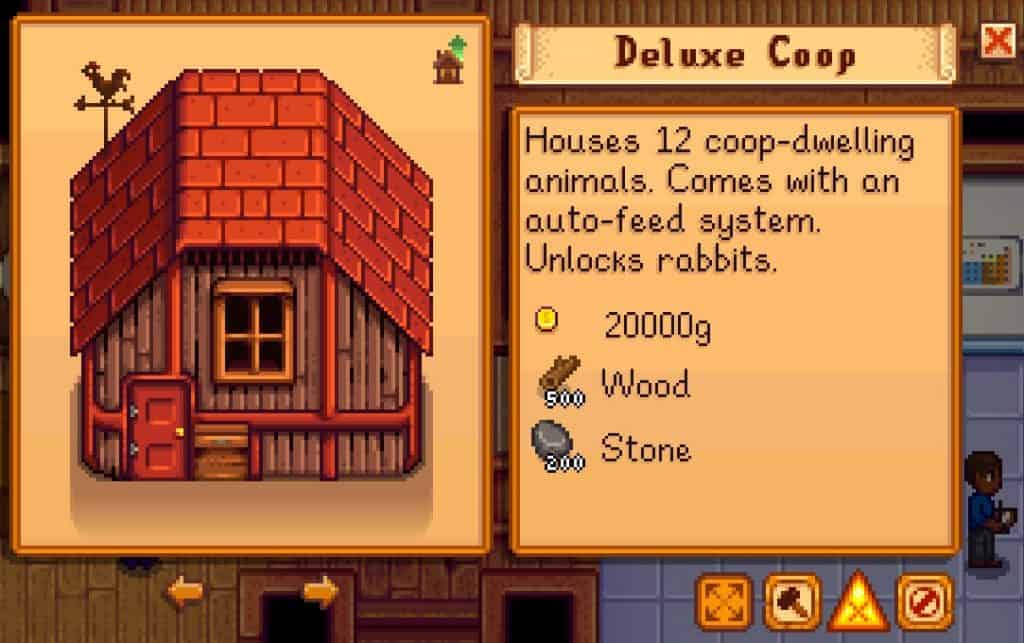
However, once you upgrade to the Deluxe model of the chicken coop (and the barn, for that matter) it comes with an automatic feeder that puts out just enough hay to feed all the animals each day, assuming there’s enough in the silos to cover all the animals on the farm.
Trust me, you don’t know how helpful they are until you just don’t have to worry about the feeding chores anymore!
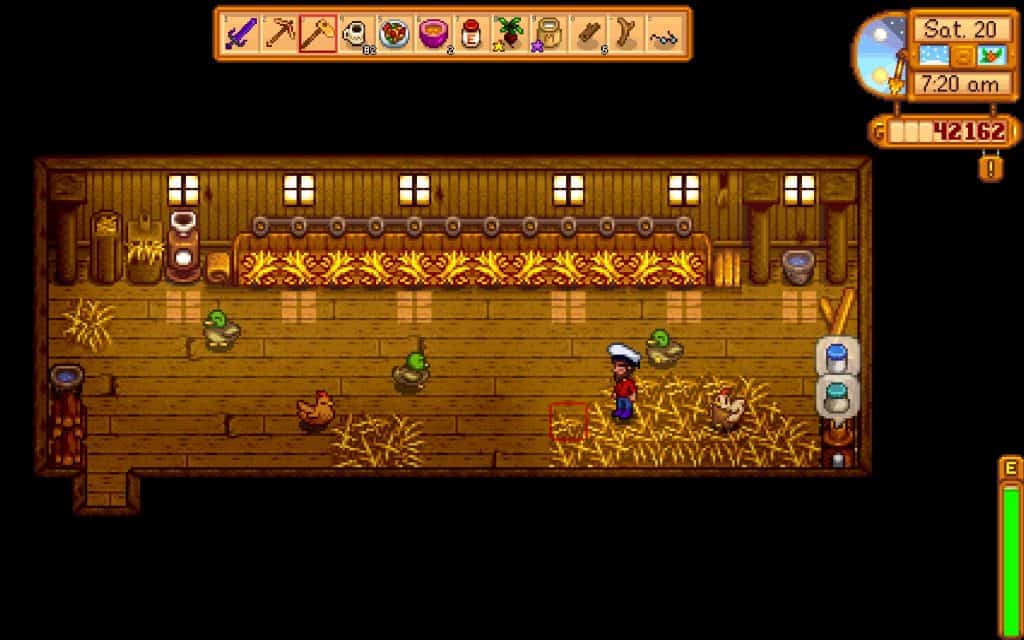
How Do Stardew Valley Chickens Grow?
Making chickens grow in Stardew Valley is all about the 3 H’s discussed earlier for keeping chickens happy: Hugs, heat, and hay. If it’s warm enough to go outside, let them out. Have a heater in the coop for winter. Give them a bit of love each morning and make sure there is always hay being put out for them to eat in the coop.
Even when you let them outside. Because sometimes all that grass is just a little too far away, and not all of them automatically feed as annoying as that can be.
Basically add in love from morning hugs and always feed them, and you’ll be good to go. Having a heater in the coop and allowing them outside to wander in grass will just be positive bonuses at that point.
How Do You Get Black Chickens in Stardew Valley?
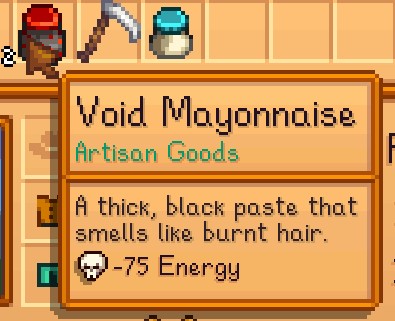
This is a fun one, and it’s one where it will be available eventually…but the timing is out of your control.
First one of the random nighttime events that Stardew Valley is known for must trigger in order for you to get a void chicken (the dark black ones).
Among the many potential nighttime events that can take place, one shows a witch flying over your coop at night and then cackling before flying off. When you come in the morning there will be a black void egg in the coop.
If you put this egg in the incubator (available in the Big Coop and Deluxe Coop) then in a few days a void chicken will be the end result.
The void chicken is all black like the egg, lays void eggs, and those eggs make void mayonnaise once tossed in a mayonnaise maker. Most people don’t particularly care for the substance and the fact this food takes away more energy than many poisions in the game is just, well hilarious.
But goblins apparently love the stuff.
Plus let’s just be honest: void chickens just look freaking cool. They deserve a home from a caring farmer, too!
Since the witch flying over the chicken coop is a randomly triggered event, you can’t necessarily control when it happens. But play long enough and as long as there’s a little bit of space in the coop, there will always be the chance of eventually getting a void egg.
UPDATE: Apparently my weird luck applies in more than one way in this game. As one of our readers and a 20+ year good friend of mine pointed out, there’s actually one MORE way to get a void chicken than the ways I listed here. Which is super great if you have terrible RNG luck and can’t get the witch to ever show up.
The solution? This Guy:

Aside from an array of other awesome goods, once you unlock the sewers and have access to Krobus’s shop, you can simply buy a Void Egg and put that in your coop’s incubator.
Fast forward a few days and you have your very own void chicken that the other coop animals keep a wary eye on 🙂
How Do You Get Blue Chickens in Stardew Valley?
Do you hate Shane? Do you find his early rudeness, gruffness, rampant alcoholism, and nihilistic look at his own life too much too deal with? If you answered “Duh,” well as painful as it might seem the first time, it’s time to go back and make friends. Give him beer, or avoid feeding the demons by giving him pizza.
The truth is that once you go through Shane’s heart event related storylines (and his is one of the better stories when you see the entire arc) and get to where you’re best buddies a very different and improved Shane offers a cut scene when you go to Marnie’s. He introduces his pride and joy: a prize blue chicken.
This makes the blue chicken available to you to after that cut scene. Cool, right?
How Do You Get Golden Chickens in Stardew Valley?
The Golden Chicken was a later addition to Stardew Valley after the famous 1.5 update, and a pretty cool one that even many experienced players don’t know about.
One of the major reasons for this is it requires finishing the Perfection achievement, which is super difficult even for very experienced Stardew players who have hundreds of hours into the game.
Once this has been done there are three ways to end up with a golden chicken:
- Buy a golden egg from Marnie for 100,000 gp and then incubate at your coop
- Buy from Qi’s Walnut Room for 100 Qi Gems
- Sometimes you get a random event where a golden witch flies over the coop and leaves a golden egg inside – like the witch with the void egg just less terrifying and less dark magic involved.
Other Common Stardew Valley Questions
Q: Why can’t I get a rabbit in Stardew Valley?
A: You probably don’t have a big enough coop. The big coop isn’t enough, you need the fully built Deluxe Coop in order to house a rabbit.
Q: Will the Dinos hurt my other animals?
A: No. Only the wild dinosaurs found in Skull Cavern in the desert will attack you. The ones you hatch from eggs in the incubator will not harm the other animals in your coop. Or elsewhere on your farm, for that matter.
Q: Should I bother to get the largest coop if I don’t care about rabbits?
I would still recommend it. If for nothing else because the Deluxe Barn and Deluxe Coop come with an auto feeder. As long as your silos have enough hay, the auto-feed system will make life way easier on you.
A Note on Ducks and Dinos and Rabbits, Oh My!
The coop starts with just chickens, which in fairness are the only animals that can be bought for the original small coop. The options open up, however, once you go to a Big Coop and even one more with Deluxe Coop. Generally speaking everything that applies to chickens applies to the other animals you get.
Ducks are just fancy chickens that quack. They give eggs every other day instead of every day and sometimes a happy duck will give you a duck feather.
Rabbits can provide some fur and an occasional rabbit’s foot, which is a cool little trinket. Dinos will leave dino eggs.
Otherwise taking care of them is the same as taking care of your chickens. Doing the same things for all animals and following the 3 H’s will provide plenty of happy animals in your coop.
Raise Those Healthy Award-Winning Chickens!
That’s all you need to know about raising healthy, happy, and profitable chickens on your farm in Stardew Valley. Keep in mind that chickens at full hearts produce better eggs, and sell for a higher amount if you decide to actually sell the animals. This isn’t something done often but maybe you went heavy with chickens and want to switch to ducks or dinosaurs, or get more of the blue or black chickens. Or just get more cash and start over.
Whatever the reason a giant coop full of happy well-fed chickens and mayo machines will produce plenty of gold for the farmer or rancher who likes seeing those gold numbers keep moving up…whether for a rainbow warp silo or a giant gold clock 🙂
Hope that helps, and if you’re interested in knowing more, please consider checking out some of the other great blog posts below. Happy gaming – and looking forward to seeing those farming screenshots!
Other Stardew Articles You May Enjoy
- Best Games Like Stardew Valley (with and without farming)
- Can Your Pets Die in Stardew Valley?
- How Do You Get Star Fruit in Stardew Valley?
Other Video Game Articles You May Love
- How Do You Unlock the Last Destination of the Hot Air Balloon in Littlewood?
- Beginner Tips for My Time at Portia
- Why Are My Plorts Disappearing in Slime Rancher?
- What Happens If You Don’t Feed Your Slimes in Slime Rancher?
- How to Earn Blue Science Points in Graveyard Keeper

Proud to embrace the locally created moniker of “Corrupt Overlord” from one of the all time great Lords of Waterdeep runs, Shane is one member of the Assorted Meeples crew and will be hard at work creating awesome content for the website. He is a long-time player of board games, one time semi-professional poker player, and tends to run to the quirky or RPG side of things when it comes to playing video games. He loves tabletop roleplaying systems like Dungeons & Dragons, Pathfinder, Werewolf, Fate, and others, and not only has been a player but has run games as DM for years. You can find his other work in publications like Level Skip or Hobby Lark.
